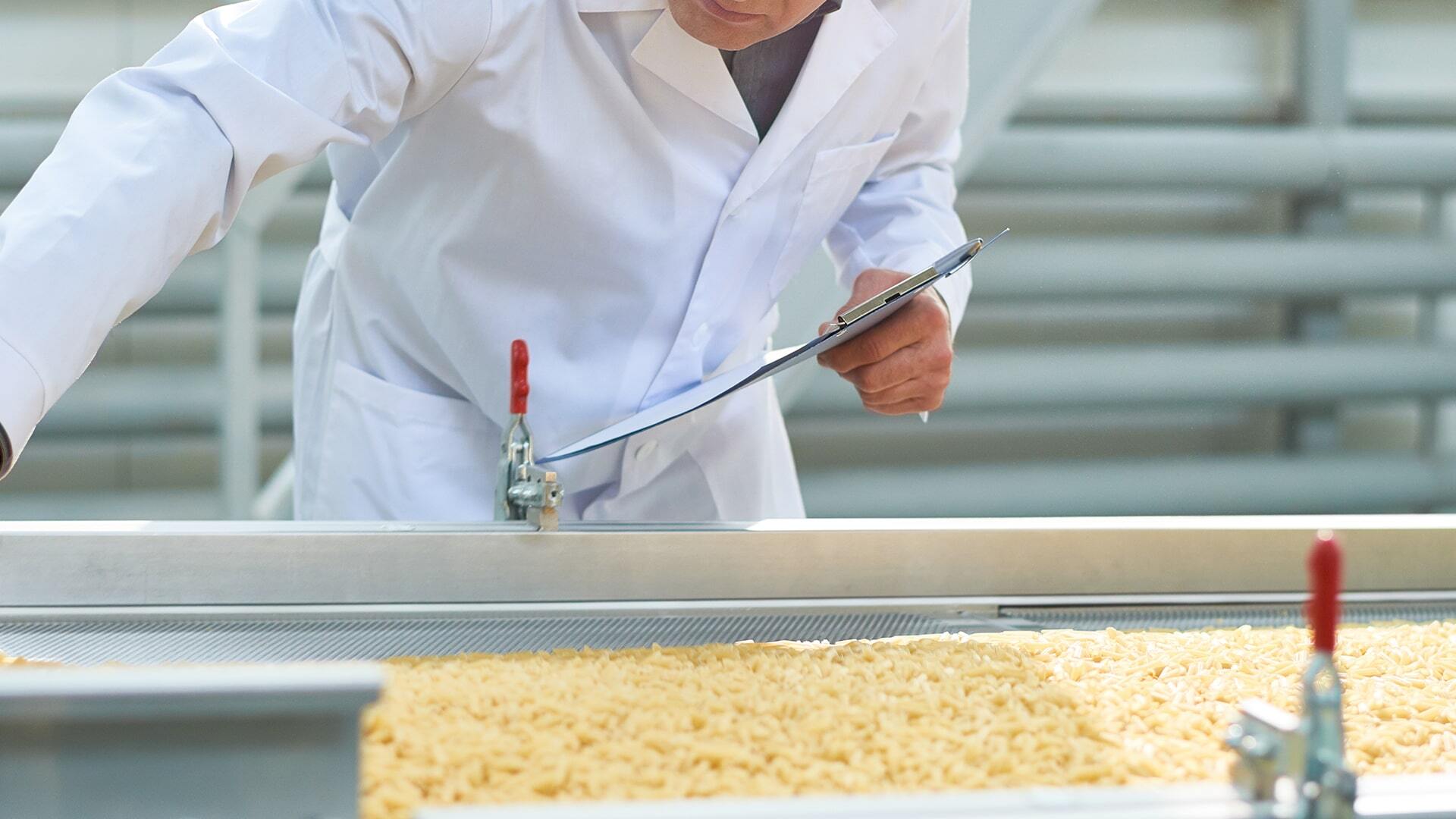6 most common foreign matter food processing contaminants

Before processed, packaged and manufactured food goods arrive on consumers' plates, they undergo stringent processing workflows and regulations to ensure safety. Like a knife and fork, safety and tasty should always go hand in hand.
However, as history has shown, breakdowns in these processes can sometimes result in food products becoming contaminated. The last thing any food manufacturer wants is for a foreign object to find its way into a product. After all, physical contaminants not only threaten consumer safety but can trigger widespread product recalls, resulting in costly business disruptions.
To help mitigate these risks, our food safety experts have identified the six most common physical contaminants found in food processing and outlined how you can safeguard your products against them.
#1 Metal contaminants
Metal contamination is a significant concern in food processing, often originating from the very equipment which is processing the food. Machinery, cutting tools and utensils can wear down over time, leading to small metal fragments shearing or flaking off and making their way into food products. This can happen due to routine wear and tear, accidental damage or improper maintenance of equipment.
Metal contaminants pose serious health risks to consumers because ingesting even a tiny metal shard can cause physical injuries, such as broken teeth, internal cuts or worse. Additionally, metal fragments can carry bacteria, which may lead to foodborne illnesses. This dual threat of physical harm and microbial contamination makes metal Public Enemy Number One on the list of dangerous contaminants for the food processing industry.
Preventing metal contamination requires diligent maintenance of all machinery and tools. Regular inspections and servicing of equipment are essential to catch any signs of wear and tear before they lead to contamination.
By prioritising equipment care and adhering to safety standards, the likelihood of metal contamination can be significantly reduced.
#2 Plastic contaminants
Plastic contamination can come from multiple sources, including packaging materials, broken equipment or even the gloves worn by workers.
Given its affordability and versatility, plastic is used extensively at every stage of production, from suppliers to manufacturers. This widespread use increases the likelihood of small plastic fragments finding their way into food products, whether from damaged containers, tools or the PPE worn by food processing operatives.
The dangers of plastic contamination go beyond mere physical hazards. Ingesting plastic can pose serious risks to consumers, such as choking, digestive blockages or internal injuries. These risks are particularly concerning in products consumed by vulnerable populations, such as children or the elderly.
Moreover, as with any form of foreign object contamination, plastic contaminants can also carry harmful chemicals, especially if they’ve been exposed to high temperatures or harsh processing conditions. These chemicals can leach into food, posing additional health risks to consumers.
This combination of physical and chemical dangers makes plastic contamination a serious concern that requires diligent attention throughout the food processing cycle.
#3 Glass contaminants
Glass containers, jars and other glass equipment is something that is used extensively in food and drink processing. Despite best efforts, accidents can and do happen, leading to broken glass that can quickly become a dangerous contaminant.
The presence of glass in food products is one of the most alarming types of contamination because it poses an immediate and severe threat to consumer safety. Physically, glass shards are typically sharp and can cause a range of injuries if ingested, from cuts in the mouth and throat to more severe internal damage.
Even the smallest sliver of glass can result in significant harm. Preventing glass contamination requires a proactive approach. This includes strict protocols for handling and storing glass containers, regular inspections to identify and address potential hazards as well as immediate cleanup and disposal of any broken glass.
Additionally, minimising the use of glass in high-risk areas or switching to safer alternatives can significantly reduce the likelihood of contamination.
#4 Paper and packaging materials
Packaging materials, such as paper, cardboard and other related components, can easily contaminate the workflow unintentionally, especially during packaging or handling stages.
The risk is heightened when packaging is being cut, torn or otherwise modified, allowing small fragments to break off and potentially mix with food products. Even though paper and cardboard are seemingly harmless materials, their presence in food is still a contamination issue that needs careful management.
While not as immediately threatening as metal, plastic or glass, paper and cardboard should not be underestimated. Consumers expect a high level of safety from the food products they purchase. Discovering a piece of paper or cardboard in their food can be damaging to the trust they have in a brand. Additionally, these contaminants can create physical discomfort or present choking hazards, particularly in products intended for very young or very old consumers.
And, as we’ve seen, any foreign body in your food can be a carrier for bacteria or other biological threats.
Preventing contamination from packaging materials requires a comprehensive approach. This includes careful handling and storing of packaging materials, regular inspections of packaging areas and ensuring that any fragments are immediately removed.
Additionally, investing in high-quality, durable packaging materials that are less prone to breaking or tearing is a good investment.
#5 Stone contaminants
Stones can infiltrate food processing environments through the involvement of raw agricultural materials like grains, fruits and vegetables. These contaminants typically originate in the fields where crops are grown. Even with rigorous cleaning processes, such as washing, sieving and mechanical sorting, it can be insufficient to the task of eliminating every small stone or insect.
Stones, if undetected, can cause damage to your processing equipment, which can lead to a domino-effect of other issues. But, stones can also cause serious physical harm to consumers, not least in the form of chipped teeth.
Preventing contamination from stones requires a multifaceted approach. It begins with thorough inspection and cleaning of raw materials before they enter the processing line.
Enhanced detection systems, such as advanced optical sorters, metal detectors and X-ray machines, are your frontline weapons in identifying and removing these contaminants.
Additionally, strict quality control measures and regular audits of the cleaning processes can help minimise the risk of stones making their way into the final food product.
#6 Hair and fibres
Hair and fibres are common yet often overlooked contaminants in food processing environments. They can come from various sources, including staff, clothing or packaging. Build-ups of static electricity and friction can result in the dislodging of small particles, which can then easily contaminate food during processing.
The presence of hair and fibres in food products, while not as physically dangerous as metal, plastic or glass, still poses significant risks to consumer perception and trust. Finding a hair or a thread in a meal can lead to customer concerns about the cleanliness and overall safety of the food manufacturing process, leading to complaints and damage to a business’ reputation.
This is why the implementation of strict hygiene protocols is important - such as wearing hairnets, beard snoods, clean uniforms and other PPE as well as employing air filtration systems. By maintaining a high standard of cleanliness and vigilance, food processors can minimise the risk of hair and fibre contamination and preserve consumer confidence in their products.
The role of Metal Detectable & X-Ray Visible Solutions in reducing foreign matter contamination
Even with the most stringent food safety protocols in place, there is always a risk that foreign objects could infiltrate the production line. This is where Metal Detectable & X-Ray Visible products come into play, providing a crucial safety net for food processors.
Let’s take a look…
Metal detectable food processing solutions
Detectamet products are designed to be identified by metal detectors, ensuring that even the smallest fragments of detectable materials - whether from equipment, tools or personal items - are caught before they contaminate food products. From pens and cable ties to scrapers and scoops, products embedded with detectable compounds make them easily traceable in food processing environments.
X-ray visible food processing solutions
While metal detection is crucial, it can’t detect non-metal contaminants like plastic or glass. X-ray systems are essential in detecting these foreign objects, using differences in material density to flag potential contaminants. This dual-detection system is particularly effective in multi-layered and complex production environments, where the risk of contamination may be higher.
Detectamet: the first choice for detectables worldwide
At Detectamet, we understand that safeguarding food production requires more than just detecting contaminants; it requires a comprehensive, proactive approach to food safety. That’s why we’ve built the world’s largest range of Metal Detectable & X-Ray Visible solutions. Our products are engineered to help you maintain the highest standards in traceability and compliance.
From our Metal Detectable and X-Ray Visible stationery and tools to PPE, each item is designed with detectability at its core, ensuring that you can catch any contaminant before it reaches your customers.
Explore the full range of products here or speak to one of our food safety specialists about enhancing your food safety protocols with Detectamet’s innovative solutions.
 Detectamet USA (English - $ USD ) Click here to change your currency, region and language.
Detectamet USA (English - $ USD ) Click here to change your currency, region and language.













